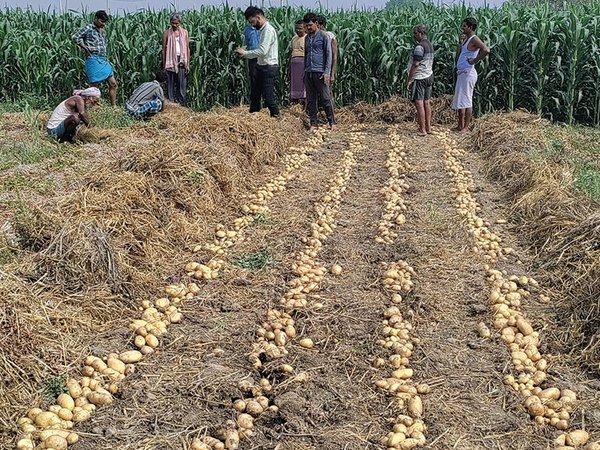 Download this article in magazine layout
Download this article in magazine layout
- Share this article
- Subscribe to our newsletter
Zero soil movement – adopting new techniques in potato production
Bihar, the third most populous State in India, is home to over 100 million people, 36 million of whom are poor. Despite these challenges, Bihar is one of the faster-growing Low-Income States. Rice and wheat are the dominant crops, but Bihar is also a significant producer of potatoes. The state grows potatoes on 0.32 million hectares, with an annual production of 5.74 million metric tons. As a “sandwich crop”, early maturing potato varieties fit in between the typical rice-wheat rotation cropping systems (also see Box at the end of the article), thus sustainably intensifying agricultural systems and providing an additional source of nutritious food and income.
A multipurpose project
In 2021, the International Potato Centre (CIP), the global not-for-profit organisation Digital Green (DG) and the Bihar Rural Livelihoods Promotion Society JEEViKA came together to introduce a new agricultural practice in the region: potato production through zero tillage and rice straw mulch (PZTM). Here, potatoes are brought out on the unworked soil and covered with rice straw after the rice has been harvested. The potatoes then mature within a mulch bed of rice straw rather than in the soil. The technique has yielded promising results in countries like China, India and Vietnam.
In Bihar, the PZTM intervention focuses on increasing the gross margins of farmers who have been cultivating rice and potatoes by efficiently using crop residues and reducing input needs. For farmers without prior potato experience, the introduction of PZTM into a rice-based system is to allow them to cultivate an additional crop to increase food production and profits. Another important objective is to improve soil quality and carbon sequestration by minimising soil operations.
Further, the intervention targets to elevate the status of women by reducing manual labour (such as ploughing, weeding and digging out potatoes during harvesting) and improving their decision-making agency. Women make up nearly 60 per cent of employment in the region’s agricultural sector, although they enjoy hardly any land ownership or decision-making power. Discriminatory social practices and restricted access to information restrain their participation in agri-food systems. The fact that India ranked 132nd out of 191 countries in the Gender Development Index in 2021 underscores the need for gender focused agricultural innovations. Working with collectives of women farmers wherein the groups are introduced to the technique aims at women gaining knowledge, self-confidence and authority through participation in PZTM training so that they can eventually take on the role of promoters. Finally, the intervention is designed to increase adoption rates of new technologies by using video-mediated extension services.
The first project cycle
The project sites included four districts in Bihar State, Nalanda, Patna, Rothas and Vaishali, which are also the most important potato producing areas. In each district, 30 villages (120 villages in all) were identified to receive training on PZTM. Many farmers in the region cultivate rice and potatoes. For the first year, a total of 461 smallholder farmers were encouraged to adopt PZTM in smaller plots or kitchen gardens, given the ongoing cultivation season and farmers’ reliance on the rented farmland for income. Trying PZTM on smaller plots was aimed at reducing risks with new techniques. Further, this approach was to empower women farmers, since the kitchen gardens are seen as their domain. To demonstrate the technique’s impact, the farmers were encouraged to cultivate potatoes using conventional techniques (ploughing the land, making furrows and then planting the seed beneath the soil) and PZTM methods on the same plot, allowing for a direct comparison of the process and results.
In order to test the effectiveness of digital extension services (DES) with the aim to increase the adoption of the new technologies, DG supported the creation of six short agronomic videos on the PZTM technique by local farmers. In collaboration with JEEViKa and its network of extension agents, the videos were disseminated to farmers through public viewings utilising women self-help groups in every village. In addition to these digital capacities, the extension workers underwent comprehensive training both on technical skills (like PZTM practice, data collection, dissemination) and soft skills (presentation skills, facilitating group discussions, guiding the farmers and providing handholding support to them through the process of PZTM) along with site visits, all with support from CIP’s experts in Bihar.
Findings from the field
As part of the overall study and project, focus group discussions were conducted to get a better understanding of farmers’ initial experiences by using PZTM. A total of five discussions were held including 13 farmers (11 female, 2 male) and 8 extension agents (6 female, 2 male) from five villages across Maner in Patna district, Noorsarai and Harnaut in Nalanda, and Muhua in Vaishali. Guided questionnaires were used to facilitate the discussions to gain insights into farmers’ journey through the adoption process, challenges faced, lessons learned along the way and the advantages and disadvantages of implementing PZTM. The following results draw from the discussions with the women farmers and extension workers from using PZTM during the November 2022 potato season.
Kitchen gardens well suited as demonstration sites. When Sushila Devi, an extension agent from Maner and farmer herself, introduced PZTM in her region, disbelief was the initial response, especially from men who doubted growing potatoes on the surface. Six women farmers adopted PZTM. Over two months, as potato saplings emerged, farmers thronged to witness accelerated growth and better quality of leaves, recognising PZTM as a better practice.
Once harvested, the shinier, spotless, larger potatoes with thinner peels tasted pleasantly different than the traditionally cultivated ones of the same seed variety. Using their plots as demonstration sites, Sushila used this opportunity to discuss the techniques with the six farmers. The group reported reduced labour input, with no reliance on men for tilling, furrowing, and harvesting – which was particularly beneficial for women without male members in their household because of work migration. Furthermore, sowing seeds shortly after rice harvest retained soil moisture, resulting in less irrigation and prolonging potato shelf life. All farmers used the ZTM potatoes for self-consumption. Sushila believed that transforming kitchen gardens into local demonstration sites would result in more farmers adopting PZTM in the next season.
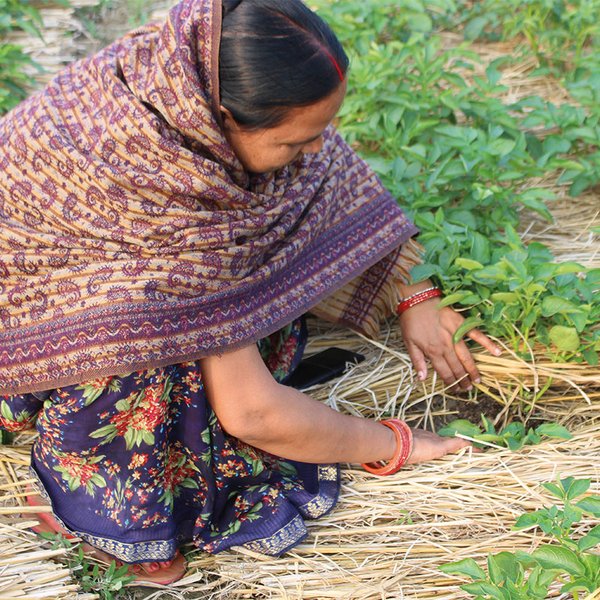
A farmer inspecting the growth of the sapling. Photo: Shams Tarique/ Digital Green
The opportunity cost of rice straw. As mentioned above, initially, the respondents could not believe potatoes could grow without soil burial. The seven farmers in Nursarai, Nalanda who tried PZTM were surprised to find that not only did the potatoes grow better but that their plots even retained moisture from the previous rice crop so the need for irrigation was reduced.
Extension agent Sangeeta Kumari explained that the adoption rates were to rise as farmers experienced the technique. The group noted accelerated growth of the saplings with reduced input needs, labour and fertilisers. As the news about the technique spread, farmers inquired about the group members’ experience, even in markets. However, the PZTM plots were often attacked by rodents like field rats. In winter, dogs tend to rearrange mulch to create warm spots for themselves. Moreover, the farmers were faced with the dilemma of straw being needed for other purposes, such as cattle feed, additional income from the sale of straw and cooking fuel. Additionally, for scaling up, the farmers estimated that they would need to acquire straw – entailing further costs.
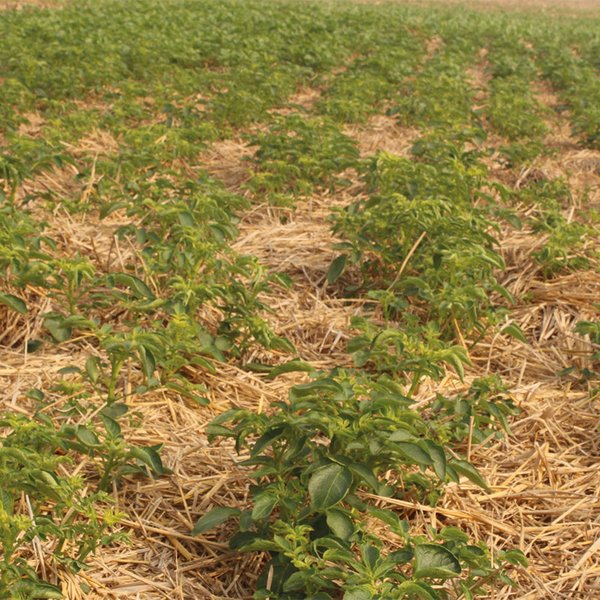
Emerging potato saplings. Photo: Shams Tarique/ Digital Green
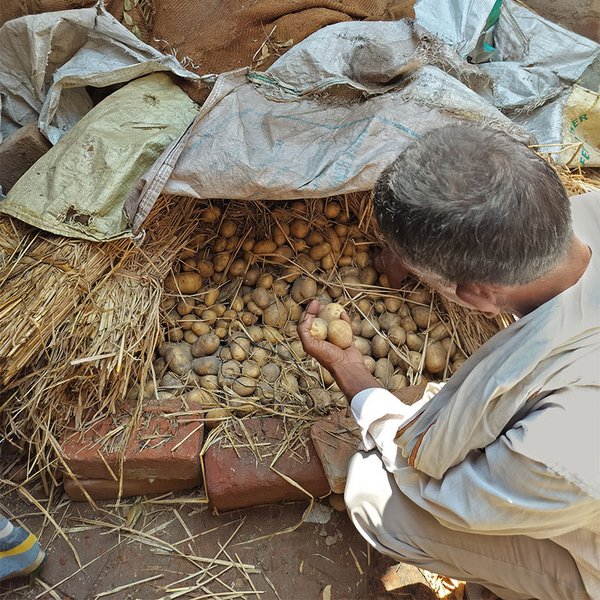
A farmer showing his harvest from PTZM technology. Photo: Anushka Rose/ Digital Green
The challenges of upscaling the technique. In Vaishali, Mahua, the opportunity to try PZTM was limited because of the ongoing cultivation season when the PZTM dissemination began in November 2022. Extension agent Sharmila Khushwaha faced challenges in convincing both men and women to come for dissemination screenings. Eventually, she was able to convince four women to adopt PZTM.
The group reported several benefits, including no need for tilling, furrowing or weeding. Irrigation could be done through sprinklers or drip irrigation, with less pesticides. Other farmers closely observed the PZTM plots. Given the positive experience of the four farmers, many more were keen to adopt the technique in their kitchen gardens’ next cycle that starts in November 2023.
However, the respondents noted challenges for farmers with fragmented landholdings. Concerns included monitoring threats from field rats, nilgai (the largest antelope in Asia), other wild animals and pre-harvest tuber theft. Uneven terrain could result in the stagnation of water, and additional straw mulch was another challenge. The group stated that while PZTM seemed viable for smaller plots or kitchen gardens, its large-scale implementation had its own set of challenges.
Gender implications. The project aimed to address gender imbalances by empowering women as knowledge holders, practitioners and PZTM advocates across villages. The technique’s introduction in Bihar’s rice-potato systems placed women at the intervention’s core. Dissemination through self-help groups played a vital role in empowering women in decision-making within agriculture. Insights from the first year highlighted the gender implications:
- PZTM reduced labour input, enabling women farmers to reduce reliance on men and eliminate the need to hire extra labour during men’s absence.
- Dissemination through self-help groups made women both primary recipients and disseminators of knowledge, fostering their empowerment by enabling them to acquire knowledge, authority, and self-confidence through training.
- By the transformation of kitchen gardens into demonstration sites, women farmers were empowered as initiators and promoters of PZTM.
- Efforts were directed at convincing men, who were primary decision-makers in major agricultural production. The extension agents and women farmers were further challenged to demonstrate PZTM’s efficiency and productivity to other farmers.
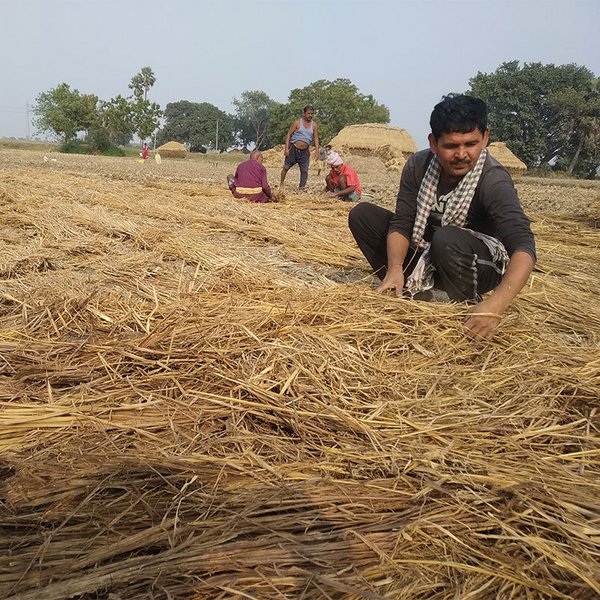
After planting, the plot is covered with mulch. Photo: Shams Tarique/ Digital Green
Overcoming barriers to behaviour change
Despite initial scepticism, a few farmers did adopt PZTM thanks to the persistent efforts of the extension agents. Access to digital extension service resources and support from field officers and experts provided constant assurance to them. Here, the extension agents played a critical role, using public screening discussions dispersed with personal experiences and training to encourage farmers.
After the first PZTM season, increased motivation and confidence among farmers was observed. Role model farmers shared their experience, anticipating a higher adoption rate in the next season. The implementation programme for the next cultivation includes a detailed dissemination strategy set to commence prior to the plantation season. This includes comprehensive training of the extension agents (in data collection, a refresher in dissemination skills along with the skills to operate PICO projectors that are used for video-mediated discussions in the villages) and extending dissemination through WhatsApp groups along with constant support and guidance from extension agents, field officers, and expert teams.
Changing behaviour takes time, but witnessing PZTM’s positive impacts will encourage farmers towards adoption. By addressing the specific needs of farmers, the barriers to adoption can be overcome, leading to broader implementation of PZTM and amplifying its benefits to farmers, especially women farmers.
PZTM in Bihar – background information
Cereal systems, and in particular rice-based systems, are the dominant type of cropping system in the Indo-Gangetic Plains. Frequently, the season after rice (November–March) is left fallow. Adding an early-maturing potato variety (75-90 days to maturity) after rice allows farmers to intensify their cropping systems in a sustainable way – by making more efficient use of land – and get an additional nutritious crop for food and income. In the study region in Bihar, the project targeted potato farmers who have rice as their preceding crop in order to encourage them to change from conventional production to conservation potato production.
The new technique allows farmers to sow seed shortly after harvesting rice when soil moisture is still relatively high, whereas with the conventional method, farmers first have to wait longer for the soil moisture to drop considerably to allow for ploughing of the fields. In many areas, without alternative uses for rice straw, the crop residues (and stubble left in the field) are burned, which is avoided under PZTM. Crop residue burning (stubble and straw) is a major issue mainly in the Western parts of the Indo-Gangetic Plains (mainly Punjab and Haryana), but is increasingly observed in Bihar and other States as well. It is usually connected with higher levels of commercialisation (and thus use of machinery) and larger areas of land.
As rice is one of the dominant crops in the region, farmers usually plant much less area with potato. About 1 hectare of rice produces rice straw for 0.5 hectare of potato (the ratio is 1:2). So if farmers cultivate 1 hectare of rice, they would use only some land/plots (and frequently different plots) for potato production. Even given the competing uses of rice straw, initial observations suggest that there should be sufficient rice straw for PZTM. Nevertheless, jointly with local research institutes, CIP explores what other alternatives could be used for mulching, such as jute gunny bags, turmeric leaves, water hyacinth, banana leaves and other leaf litter freely available to the farmers.
Potato Zero Tillage under Rice Straw Cultivation for Smallholders (PZTM), commissioned by the German Federal Ministry for Economic Cooperation and Development (BMZ), is part of the Fund for the Promotion of Innovation in Agriculture (i4Ag) and is being carried out by the International Potato Center (CIP) on behalf of Deutsche Gesellschaft für Internationale Zusammenarbeit (GIZ) GmbH.
Anushka Rose is a Program Officer at Digital Green in Delhi, India, specialising in development practice with grounded research experience. She focuses on elevating rural voices in central India through ethnographic methods, dedicated to empowering marginalised communities.
Namita Singh is Director - Strategy, Knowledge and MEL at Digital Green, based in India. Her work looks at the intersection of gender, technology and participatory approaches with rural communities.
Jan Kreuze is the leader of crop and system sciences division of the International Potato Center (CIP) in Lima, Peru and adjunct professor in plant pathology at the University of Helsinki, Finland. His current research focus is on sustainable intensification and climate adaptation of agricultural systems.
Marcel Gatto is a Scientist – Agricultural Economist at the International Potato Center based in South Africa. He is a Senior Research Fellow at the University of Witwatersrand in Johannesburg, South Africa. His research interests are in developing seed systems, food and nutrition security, and conservation agriculture.
Contact: m.gatto@cgiar.org


